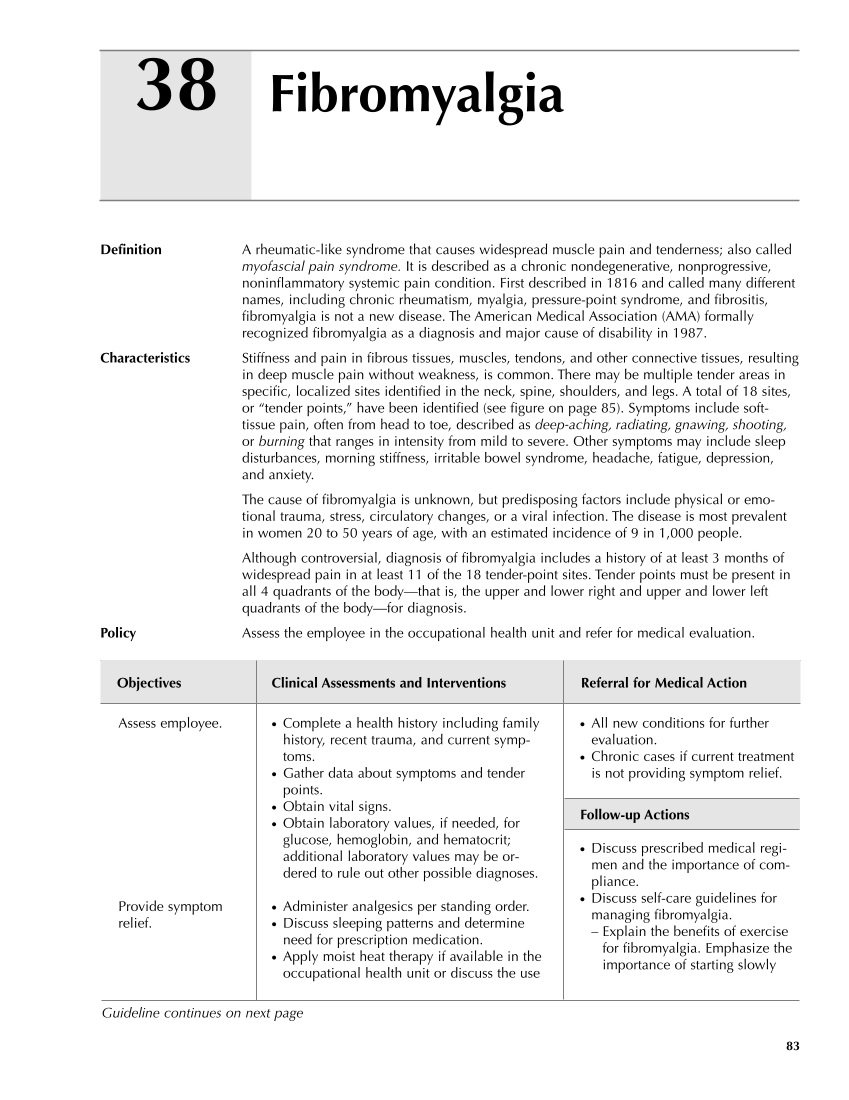83 Fibromyalgia 38 Definition A rheumatic-like syndrome that causes widespread muscle pain and tenderness also called myofascial pain syndrome. It is described as a chronic nondegenerative, nonprogressive, noninflammatory systemic pain condition. First described in 1816 and called many different names, including chronic rheumatism, myalgia, pressure-point syndrome, and fibrositis, fibromyalgia is not a new disease. The American Medical Association (AMA) formally recognized fibromyalgia as a diagnosis and major cause of disability in 1987. Characteristics Stiffness and pain in fibrous tissues, muscles, tendons, and other connective tissues, resulting in deep muscle pain without weakness, is common. There may be multiple tender areas in specific, localized sites identified in the neck, spine, shoulders, and legs. A total of 18 sites, or “tender points,” have been identified (see figure on page 85). Symptoms include soft- tissue pain, often from head to toe, described as deep-aching, radiating, gnawing, shooting, or burning that ranges in intensity from mild to severe. Other symptoms may include sleep disturbances, morning stiffness, irritable bowel syndrome, headache, fatigue, depression, and anxiety. The cause of fibromyalgia is unknown, but predisposing factors include physical or emo- tional trauma, stress, circulatory changes, or a viral infection. The disease is most prevalent in women 20 to 50 years of age, with an estimated incidence of 9 in 1,000 people. Although controversial, diagnosis of fibromyalgia includes a history of at least 3 months of widespread pain in at least 11 of the 18 tender-point sites. Tender points must be present in all 4 quadrants of the body—that is, the upper and lower right and upper and lower left quadrants of the body—for diagnosis. Policy Assess the employee in the occupational health unit and refer for medical evaluation. Objectives Clinical Assessments and Interventions Referral for Medical Action ● All new conditions for further evaluation. ● Chronic cases if current treatment is not providing symptom relief. Follow-up Actions ● Discuss prescribed medical regi- men and the importance of com- pliance. ● Discuss self-care guidelines for managing fibromyalgia. – Explain the benefits of exercise for fibromyalgia. Emphasize the importance of starting slowly Assess employee. Provide symptom relief. ● Complete a health history including family history, recent trauma, and current symp- toms. ● Gather data about symptoms and tender points. ● Obtain vital signs. ● Obtain laboratory values, if needed, for glucose, hemoglobin, and hematocrit additional laboratory values may be or- dered to rule out other possible diagnoses. ● Administer analgesics per standing order. ● Discuss sleeping patterns and determine need for prescription medication. ● Apply moist heat therapy if available in the occupational health unit or discuss the use Guideline continues on next page
Purchased from OEM Press by (ge corporate access). (C) 2013 OEM Health Information, Inc. All rights reserved.












































































































































































































































































































































































































































